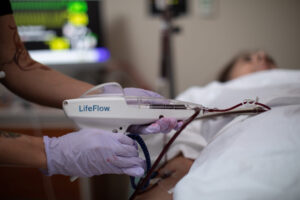
As an emergency physician, I routinely have to make quick decisions that can impact the direction and quality of care for my patients. With the current high nursing turnover and short-staffing on many shifts, these decisions are even more important, as they can also positively or negatively impact provider stress and patient flow. Streamlined care for critical patients is extremely helpful to the team and for patient care.
GI bleed cases can be difficult to manage as patients can rapidly decompensate, leading to intensive resource use. For GI bleed patients who experience shock, all-cause in-hospital mortality has been reported at 17%. In 2021 we added LifeFlow® PLUS Blood & Fluid Infuser as an alternative to our current tools for rapid blood transfusion in a hemorrhagic shock patient. Recently I have treated several GI bleed patients for whom LifeFlow PLUS was particularly helpful. In one case the GI-bleed patient presented hypotensive and in shock. Recognizing the importance of rapid response, my team grabbed a LifeFlow and delivered 2 units of blood in approximately 6 minutes. The quick transfusion yielded immediate results, as we were able to stabilize the patient within minutes. We would never have been able to administer blood this quickly if we had to track down and set up the Level 1 Rapid Infuser or if we used a pressure bag or a pump.
Adding LifeFlow PLUS to our toolkit for hemorrhagic shock patients has significantly enhanced our ability to respond immediately and stabilize a crashing patient. By stabilizing the patients more quickly we have been able to move them to their next phase of care, leading to faster disposition and throughput which then allows the ER team to focus on the next patient. And, because it is lightweight and portable, when the Emergency Department is overcrowded and we have no treatment rooms available, I have been able to use LifeFlow PLUS to transfuse blood in our triage room.
Anecdotally, I’m also seeing that when patients receive early, rapid transfusion with LifeFlow, they require fewer overall resources. For example, in a recent case we initially called the ICU for admission for a hemorrhagic shock patient, but once the patient was transfused using LifeFlow and rapidly stabilized, we concluded that ICU admission could be avoided.
LifeFlow has become a critical tool in our toolkit for GI bleed and other hemorrhagic shock patients. In my experience, we are able to more quickly restore adequate perfusion and stabilize the patient, resulting in more streamlined and improved care.

